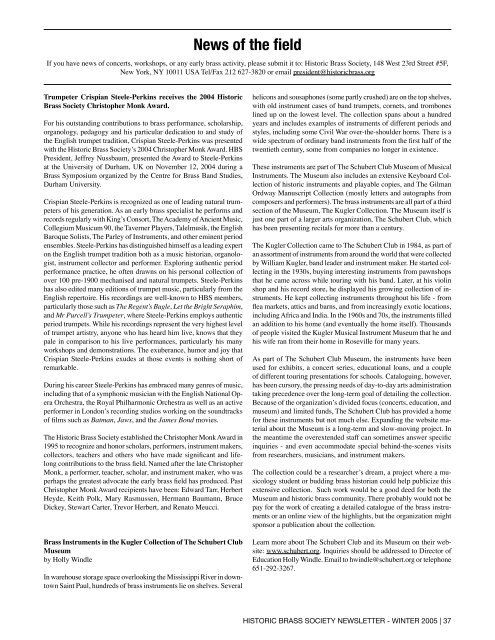18 News - Historic Brass Society
18 News - Historic Brass Society
18 News - Historic Brass Society
Create successful ePaper yourself
Turn your PDF publications into a flip-book with our unique Google optimized e-Paper software.
If you have news of concerts, workshops, or any early brass activity, please submit it to: <strong>Historic</strong> <strong>Brass</strong> <strong>Society</strong>, 148 West 23rd Street #5F,<br />
New York, NY 10011 USA Tel/Fax 212 627-3820 or email president@historicbrass.org<br />
Trumpeter Crispian Steele-Perkins receives the 2004 <strong>Historic</strong><br />
<strong>Brass</strong> <strong>Society</strong> Christopher Monk Award.<br />
For his outstanding contributions to brass performance, scholarship,<br />
organology, pedagogy and his particular dedication to and study of<br />
the English trumpet tradition, Crispian Steele-Perkins was presented<br />
<br />
President, Jeffrey Nussbaum, presented the Award to Steele-Perkins<br />
at the University of Durham, UK on November 12, 2004 during a<br />
<strong>Brass</strong> Symposium organized by the Centre for <strong>Brass</strong> Band Studies,<br />
Durham University.<br />
Crispian Steele-Perkins is recognized as one of leading natural trumpeters<br />
of his generation. As an early brass specialist he performs and<br />
<br />
Collegium Musicum 90, the Taverner Players, Talelmusik, the English<br />
Baroque Solists, The Parley of Instruments, and other eminent period<br />
ensembles. Steele-Perkins has distinguished himself as a leading expert<br />
on the English trumpet tradition both as a music historian, organologist,<br />
instrument collector and performer. Exploring authentic period<br />
performance practice, he often drawns on his personal collection of<br />
over 100 pre-1900 mechanised and natural trumpets. Steele-Perkins<br />
has also edited many editions of trumpet music, particularly from the<br />
English repertoire. His recordings are well-known to HBS members,<br />
particularly those such as , Let the Bright Seraphim,<br />
and , where Steele-Perkins employs authentic<br />
period trumpets. While his recordings represent the very highest level<br />
of trumpet artistry, anyone who has heard him live, knows that they<br />
pale in comparison to his live performances, particularly his many<br />
workshops and demonstrations. The exuberance, humor and joy that<br />
Crispian Steele-Perkins exudes at those events is nothing short of<br />
remarkable.<br />
During his career Steele-Perkins has embraced many genres of music,<br />
including that of a symphonic musician with the English National Opera<br />
Orchestra, the Royal Philharmonic Orchestra as well as an active<br />
<br />
Batman, Jaws, and the movies.<br />
The <strong>Historic</strong> <strong>Brass</strong> <strong>Society</strong> established the Christopher Monk Award in<br />
1995 to recognize and honor scholars, performers, instrument makers,<br />
<br />
<br />
Monk, a performer, teacher, scholar, and instrument maker, who was<br />
<br />
Christopher Monk Award recipients have been: Edward Tarr, Herbert<br />
Heyde, Keith Polk, Mary Rasmussen, Hermann Baumann, Bruce<br />
Dickey, Stewart Carter, Trevor Herbert, and Renato Meucci.<br />
<strong>Brass</strong> Instruments in the Kugler Collection of The Schubert Club<br />
Museum<br />
by Holly Windle<br />
In warehouse storage space overlooking the Mississippi River in downtown<br />
Saint Paul, hundreds of brass instruments lie on shelves. Several<br />
helicons and sousaphones (some partly crushed) are on the top shelves,<br />
with old instrument cases of band trumpets, cornets, and trombones<br />
lined up on the lowest level. The collection spans about a hundred<br />
years and includes examples of instruments of different periods and<br />
styles, including some Civil War over-the-shoulder horns. There is a<br />
<br />
twentieth century, some from companies no longer in existence.<br />
These instruments are part of The Schubert Club Museum of Musical<br />
Instruments. The Museum also includes an extensive Keyboard Collection<br />
of historic instruments and playable copies, and The Gilman<br />
Ordway Manuscript Collection (mostly letters and autographs from<br />
composers and performers). The brass instruments are all part of a third<br />
section of the Museum, The Kugler Collection. The Museum itself is<br />
just one part of a larger arts organization, The Schubert Club, which<br />
has been presenting recitals for more than a century.<br />
The Kugler Collection came to The Schubert Club in 1984, as part of<br />
an assortment of instruments from around the world that were collected<br />
by William Kugler, band leader and instrument maker. He started collecting<br />
in the 1930s, buying interesting instruments from pawnshops<br />
that he came across while touring with his band. Later, at his violin<br />
shop and his record store, he displayed his growing collection of instruments.<br />
He kept collecting instruments throughout his life - from<br />
<br />
<br />
an addition to his home (and eventually the home itself). Thousands<br />
of people visited the Kugler Musical Instrument Museum that he and<br />
his wife ran from their home in Roseville for many years.<br />
As part of The Schubert Club Museum, the instruments have been<br />
used for exhibits, a concert series, educational loans, and a couple<br />
of different touring presentations for schools. Cataloguing, however,<br />
has been cursory, the pressing needs of day-to-day arts administration<br />
taking precedence over the long-term goal of detailing the collection.<br />
<br />
museum) and limited funds, The Schubert Club has provided a home<br />
for these instruments but not much else. Expanding the website material<br />
about the Museum is a long-term and slow-moving project. In<br />
<br />
inquiries - and even accommodate special behind-the-scenes visits<br />
from researchers, musicians, and instrument makers.<br />
sicology<br />
student or budding brass historian could help publicize this<br />
extensive collection. Such work would be a good deed for both the<br />
Museum and historic brass community. There probably would not be<br />
pay for the work of creating a detailed catalogue of the brass instruments<br />
or an online view of the highlights, but the organization might<br />
sponsor a publication about the collection.<br />
Learn more about The Schubert Club and its Museum on their website:<br />
www.schubert.org. Inquiries should be addressed to Director of<br />
Education Holly Windle. Email to hwindle@schubert.org or telephone<br />
651-292-3267.<br />
HISTORIC BRASS SOCIETY NEWSLETTER - WINTER 2005 | 37
















